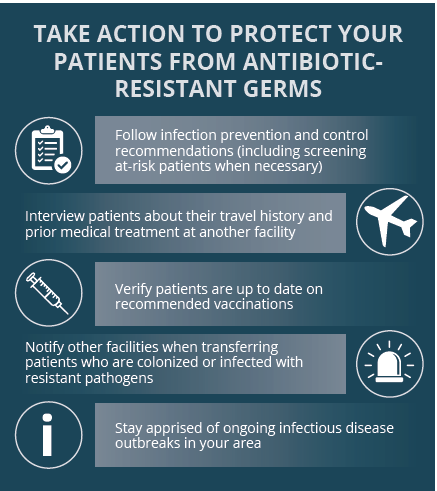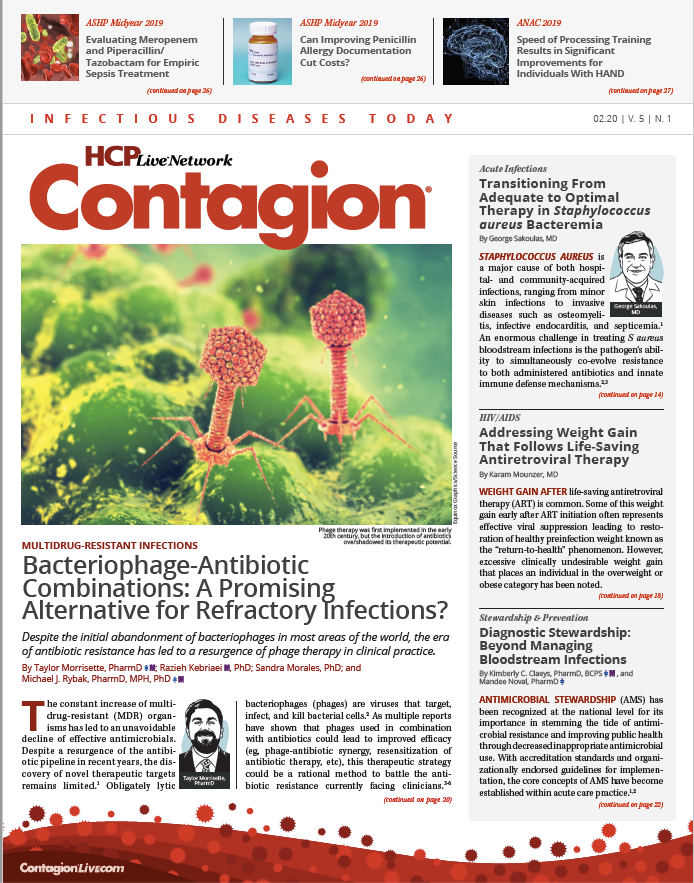Five Ways ID Clinicians Can Take On Antibiotic Resistance: Highlights From the CDC's Latest Report
A death from an antibiotic-resistant infection occurs about every 15 minutes in the United States. The CDC’s 2019 threat report dives into national infection estimates and actions we can take to combat this threat.
The second groundbreaking report from the US Centers for Disease Control and Prevention (CDC) concerning antibiotic resistance (AR) shows that more people are dying from AR in the United States than previously estimated in 2013—but underscores that infection prevention is saving lives.
AR can affect anyone at any time. More than 2.8 million antibiotic-resistant infections occur in the United States each year, and more than 35,000 people die as a result. In addition, 223,900 cases of Clostridioides difficile occurred in hospitalized patients in 2017 and at least 12,800 people died. These data are not merely statistics—they represent people. In November 2019, the CDC released Antibiotic Resistance Threats in the United States, 2019, calling for continued action to combat this threat and save lives.1
Although this threat is never ending, this report and other data sources show that with the right tools and practices, we can protect people from infections and related complications. Since the first AR Threats Report released in 2013, the number of deaths caused by antibiotic-resistant infections has been reduced by 18% overall and by nearly 30% in hospitals alone. This success is driven by public-private partnerships to prevent infections in the first place, slow the development of resistance through better antibiotic use, and stop the spread of resistance when it does develop.
Yet the number of people facing AR in the United States is still too high. The report lists 18 antibiotic-resistant bacteria and fungi into 3 categories based on level of concern to human health—urgent, serious, and concerning. Pathogens will continue to develop resistance and, without continued action, could undo the nation’s progress. The CDC’s report calls out many areas needing enhanced action, and 5 are included in this article.
INCREASE PREVENTION IN YOUR COMMUNITY
The CDC is concerned about rising antibiotic-resistant infections in the community, including those that can lead to sepsis. This can put many people at risk, make the spread of germs more difficult to contain, and threaten the progress made to protect patients. For example, 2 pathogens listed in the report causing infections have more than doubled since the last report—drug-resistant gonorrhea and group A Streptococcus. Also, certain types of Enterobacteriaceae, which can cause antibiotic-resistant urinary tract infections, are on the rise.
Stopping the spread of resistant threats in the community requires specific interventions. Health care providers can talk to patients about proper hygiene, routine vaccination, safer sex practices, safe food preparation, and ways to prevent spread. Many of these interventions have already proven successful. For example, family doctors recommending vaccines have protected their patients from pneumococcal infections. The PCV13 vaccine, which the US Food and Drug Administration (FDA) licensed in 2010, protects people from 13 types of pneumococcus, including resistant forms. This vaccine prevented more than 30,000 cases of invasive pneumococcal disease and 3000 deaths from 2010 to 2013 alone.
TAKE AGGRESSIVE ACTION IN HEALTH CARE
Antibiotic-resistant health care—associated pathogens can spread from patient to patient and across facilities. Infection prevention programs in hospitals have been critical to helping decrease antibiotic-resistant infections and their spread, but these gains will only be temporary without continued action and without similar control efforts in other health care facilities such as long-term care. Antibiotic-resistant pathogens can move back and forth between health care facilities and communities, becoming much harder to control.
Health care providers can follow infection prevention and control recommendations, including screening at-risk patients when indicated, to stop infections before they begin. This step includes staying informed of current outbreaks and alerting receiving facilities when transferring patients who are colonized or infected with antibiotic-resistant germs.
If new or rare resistance is identified, the CDC’s Containment Strategy—aggressive detection and response activities—can keep these uncommon antibiotic-resistant genes or germs from spreading when launched at the first sign of a problem. For the “nightmare bacteria” carbapenem-resistant Enterobacteriaceae alone, aggressive containment responses could prevent 1600 cases in just 1 state over 3 years.
WATCH FOR EMERGING THREATS
The report’s Watch List includes 3 threats that have not spread resistance widely or that are poorly understood in the United States and could become common without a continued aggressive approach. Comprehensive prevention and response are needed to ensure that the 3 Watch List threats—drug-resistant Aspergillus fumigatus, Mycoplasma genitalium, and Bordetella pertussis—do not become threats here. There is the potential for these resistant germs to spread among cities, states, and countries.
The CDC and other public health experts are closely monitoring these germs. CDC’s AR Laboratory Network provides health care facilities and public health departments access to gold-standard public health lab testing to help detect emerging threats and prevent the spread of antibiotic resistance. As of 2018, every 4 hours, the AR Lab Network detected a resistant germ carrying a mechanism that required a public health investigation.
The report also highlights a new urgent threat, the fungus Candida auris that was not listed in the 2013 report. Vigilant surveillance and aggressive action in health care by infectious disease experts nationwide have, in many cases, helped contain this threat, which kills more than 1 in 3 patients with invasive C auris infection.
Health care providers need to ask patients if they recently received care in another facility or traveled to another country. Early detection of resistant germs within the United States, followed by implementation of prevention strategies, could reduce spread and public health impact.
REMEMBER MECHANISMS
The emergence and spread of new forms of resistance remains a concern. To survive the effects of antibiotics, pathogens are constantly finding new defense strategies, called “resistance mechanisms.” These mechanisms can change over time and lead to more resistant infections. Alarmingly, antibiotic-resistant pathogens can share their resistance genes with other pathogens that have not been exposed to antibiotics. Bacteria and fungi can carry genes for many types of resistance. When already hard-to-treat pathogens have the right combination of resistance genes, it can make all antibiotics ineffective, resulting in untreatable infections.
Health care providers need to be aware of resistance patterns in the area and work with their clinical and public health labs to receive immediate notification when antibiotic-resistant germs are identified in patients. Knowing when to report cases and submit resistant isolates to the health department can drastically help identify unusual resistance or treatment failures.
DISCOVERING INNOVATIVE ALTERNATIVES
We need to develop new antibiotics and come up with new and better ways to prevent, detect, and treat infections. Bacteria and fungi continuously change and develop new ways to resist antibiotics. The report highlights the need for innovative alternatives, such as antibodies, bacteriophages, fecal microbiota transplant, and vaccines. Researchers are testing vaccines to prevent various types of Streptococcus infections (eg, those caused by groups A and B) and C difficile infection.
To support innovative efforts in diagnostics and drug development, the CDC & FDA AR Isolate Bank provides curated collections of resistant organisms gathered through CDC’s outbreak response and surveillance programs. The isolates represent samples from health care—associated, foodborne, gonorrhea, and community-associated infections. The AR Isolate Bank helps, for example, inform research and development, perform testing to ensure drug effectiveness, study mechanisms, and detect public health resistance threats. This work ultimately improves patient care and builds solutions against resistance threats.
Preventing infections in the first place, stopping the spread of resistance when it does develop, slowing the development of resistance through better antibiotic use, and supporting innovations for better outcomes will help protect people. We all have a role to play—be alert in your community and facility and act to protect patients.

The findings and conclusions in this report are those of the authors and do not necessarily represent the official position of the CDC.
Avery provides strategic communications expertise to CDC leadership related to the nation’s efforts to combat AR. As a senior communications specialist within CDC’s AR Coordination & Strategy Unit, Lacey leads communications projects and initiatives, including the internationally recognized 2019 AR Threats Report. (Contracted by Chenega.)Capers communications lead for CDC’s AR Coordination & Strategy Unit, uses communication strategies to empower domestic and global audiences to actively combat antibiotic resistance and to increase awareness of CDC’s effective AR portfolio. Her team creates products such as the 2019 AR Threats Report, the AR Investment Map, infographics, videos, and other digital content to drive behavior change.Cardo is the director of the Division of Healthcare Quality Promotion at the Centers for Disease Control and Prevention. Cardo has been involved in health care epidemiology and hospital infections since 1984 and is internationally recognized as an expert and leader in the area.Coffin is CDC’s Senior Advisor for Strategic Policy, Partnership, and Communications in the Division of Healthcare Quality Promotion. In this role, she oversees the strategic direction of the policy, partnership, and communications teams to ensure consistent messaging and maximize the interactions with CDC’s internal and external stakeholders related to CDC’s patient safety portfolio. Craig leads the coordination of CDC’s cross-cutting antibiotic resistance activities by developing and guiding CDC’s strategic direction to address national goals to combat antibiotic resistance. In 2016, Michael led the team that was awarded HHS Secretary’s Award for Distinguished Service, the highest internal award, for implementing the first White House One Health Antibiotic Stewardship Forum.
Reference:
- CDC. Antibiotic Resistance Threats in the United States, 2019. Atlanta, GA: U.S. Department of Health and Human Services, CDC; 2019. https://www.cdc.gov/drugresistance/pdf/threats-report/2019-ar-threats-report-508.pdf. Accessed January 5, 2020.
>>Read more Emerging/Re-Emerging Infections articles:
December 2019: Hepatitis A Outbreaks on the Rise in the US
October 2019: With the Opioid Epidemic, Communities See Dramatic Increases in Infectious Diseases
August 2019: 2019: Measles Outbreaks in the United States

